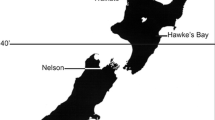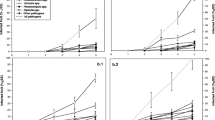Abstract
This study identified sources of fungal spores causing postharvest infection of pome fruit and established relationships between inoculum concentrations of Penicillium expansum and wet core rot of apple. Twenty-four of 35 picking bins contained pathogenic fungi on the wood surfaces, including Alternaria sp., Mucorpiriformis, and five species of Penicillium. Pathogenic fungi were isolated from 9 of 12 packing shed water systems used to dip or dump fruit. P. expansum was recovered most frequently in mean concentrations of 133 and 44 spores/ml in dip and dump water, respectively. Relationships between the natural logarithm of the inoculum concentration of P. expansum and wet core rot were linear. Spores in diphenylamine emulsion caused more core rot than spores in water. This was probably due to increased penetration of the emulsion as well as injury caused to the core tissues by a component of the formulation. The sanitation of bins and packing shed water is important in the control of postharvest decay.
Similar content being viewed by others
References
Adams, R.E. and Tamuro, S.E. (1959)—Treatment of field boxes for the control of postharvest rots of peaches and storage rots of apples. Plant Disease Reporter 43: 396–400.
Baker, K.F. and Heald, F.D. (1934)—Investigations on methods of control of the blue-mould decay of apples. Washington Agriculture Experiment Station Bulletin 304: 1–32.
Blanpied, G.D. and Purnasiri, A. (1968)—Penicillium and Botrytis rot of Mcintosh apples handled in water. Plant Disease Reporter 52: 865–867.
Combrink, J.C. and Ginsburg, L. (1973)—Core rot in Starking apples — a preliminary investigation into the origin and control. The Deciduous Fruit Grower 23: 16–19.
Fisher, D.F. and Reeves, E.L. (1928)—The influence of cleaning treatment on storage diseases of apples and pears. Proceedings of the 32nd Annual Meeting of the Idaho State Horticulture Society. 15pp.
Heald, F.D., Neiler, J.R. and Overley, FL. (1928)—Arsenical spray residue and its removal from apples and pears. State College of Washington Agriculture Experiment Station Bulletin 226. 100pp.
Holmes, R.J. (1988)—Resistance in blue mould of apple and pear to post harvest fungicides. Biennial Research Report, Horticultural Research Institute, Knoxfield, Australia 1985–86.
Johnson, D, Sharpies, R. and Hirns, M. (1986)—The dip and rot link unravelled. Grower 106: 52–54.
Michailides, T.J. and Spotts, R.A. (1986)—Factors affecting dispersal of Mucor piriformis in pear orchards and into the packing house. Plant Disease 70: 1060–1063.
Pierson, CF. Ceponis, M.J. and McColioch, LP. (1971)— Market diseases of apples, pears and quinces. United States Department of Agriculture, Agriculture Handbook 376. 112pp.
Pitt, J.I. (1979)—The genus Penicillium and it steleomorphic states Eupenicillium and Taiaromyces. Academic Press, Sydney. 634pp.
Savulescu, D. and Tudosescu, V. (1968)—L’influence des rayons ultraviolets sur lacroissance et la sporulation de quelque especes de champignons. Revue Roumaine de Biologie Serie de Biology 13: 141–144.
Spotts, R.A. (1985a)—Effect of preharvest pear fruit maturity on decay resistance. Plant Disease 69: 388–390.
Spotts, R.A. (1985b)—Environmental factors affecting conidial survival of five pear decay fungi. Plant Disease 69: 391–392.
Spotts, R.A. (1986)—Relationships between inoculum concentrations of three decay fungi and pear fruit decay. Plant Disease 70: 386–389.
Spotts, R.A. and Cervantes, L.A. (1986)—Populations, pathogenicity, and benomyl resistance of Botrytis spp., Penicillium spp., and Mucor piriformis in packing houses. Plant Disease 70: 106–108.
Spotts, R.A., Holmes, R.J. and Washington, W.S. (1988)— Factors affecting wet core rot of apple. Australasian Plant Pathology 17: 53–57.
Washington, W.S. (1982)—Mouldy core of red delicious apples. Department of Agriculture and Rural Affairs, Victoria. Agnote Order No. 2007/82. 3pp.
Washington, W.S. (1987)—Core rots in Australia — A summary of studies into the problem 1978-1981. Proceedings of Department of Agriculture and Rural Affairs, Victoria Seminar: Post-harvest decay in pome fruit, Wantirna. 51pp.
Wong, J.A.L. and O’Loughlin, J. (1987)—Core rot control. Apple and Pear News 4: 3–5.
Author information
Authors and Affiliations
Rights and permissions
About this article
Cite this article
Spotts, R.A., Holmes, R.J. & Washington, W.S. Sources of spores and inoculum concentrations related to postharvest decay of apple and pear. Australasian Plant Pathology 17, 48–52 (1988). https://doi.org/10.1071/APP9880048
Received:
Accepted:
Issue Date:
DOI: https://doi.org/10.1071/APP9880048




